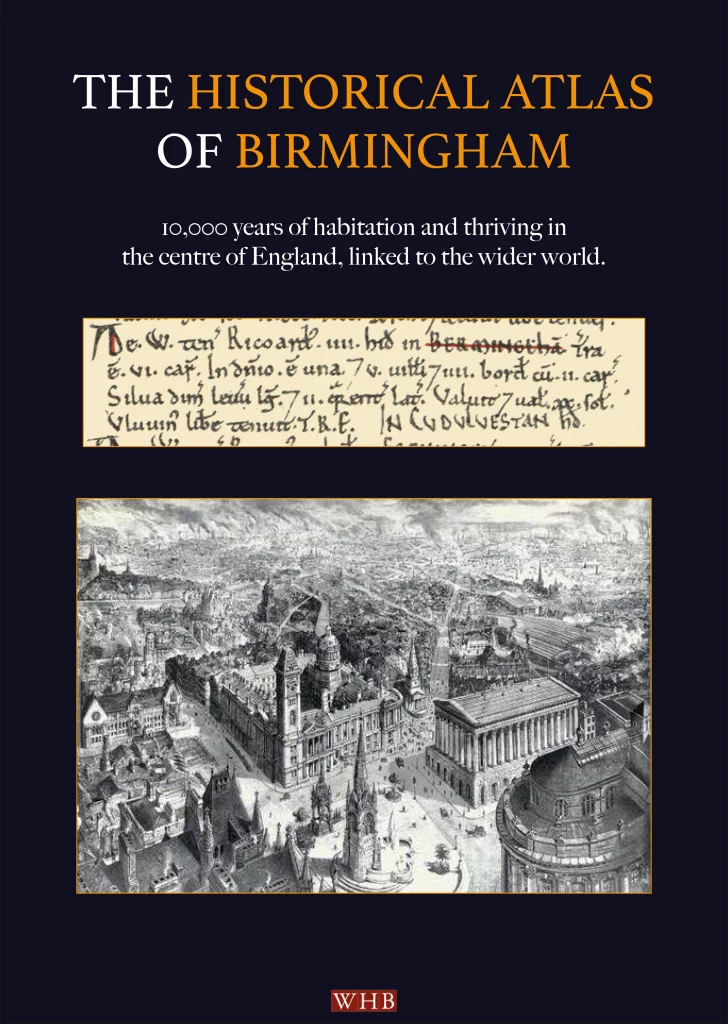
Full edition in hardback
Concise paperback edition
eBook
Audiobook
Braille edition
Graphic novel
Posters
Full edition
Size: 380 mm height x 270 mm width subject to minor revision
Supported with pioneering maps, graphs, tables, charts and artwork of historical scenes and subject matter
In full colour except for glossaries and index
Pagination: c. 320 pp
Concise edition:
Size: To be announced
c. 200 pp
In full colour except for glossaries and index
unprecedented in scope, scale and approaches.
‘The Historical Atlas of Birmingham is innovative, exciting, and thought-provoking. This pioneering project will enhance our knowledge and understanding of the many layers of Birmingham’s past and transform our appreciation of the city’s people in a dynamic and visually stimulating way. Drawing on numerous and varied primary sources, it will bring to the fore the dynamic relationships between people, place, and landscape, and highlight beliefs, class, culture, language, and much more. Crucially, the Atlas will reach out from the local to the regional, national, and global, embedding Birmingham and its people within the broader contexts of time and place.’
Professor Carl Chinn MBE, DL, Ph.D., F.Birm.Soc.
Outline
Drawing on a vast scope of material evidence, primary sources and scholarship, The Historical Atlas of Birmingham (HAB) presents the incredible story of 10,000 years of archaeology and history of Britain’s second city, home to 1.145 million persons in 103 square miles/268 square kilometres within the city boundaries and 4.3 million persons in the wider metropolitan area. This pioneering project contributes to knowledge and understanding of notable and subtle elements and aspects of Birmingham’s many layers of history and heritage and its vast hinterland. Relationships of people, places and phenomena are addressed at different scales. A well-conceptualised and innovative project the HAB features much new scope, depth, nuance and dynamism. Habitation, population, farming, production, commerce and trade, knowledge and education, language, literature, textiles, pottery, culture, governance, invasions and war, law and order, art and architecture, furniture and interior design, fashion, motifs and patterns, medicine, surgery, pharmacy, science, industry, technology, migration, urban growth, transportation, music, gardens, parks, flora, fauna, wildlife, pets and many other subjects are explored. An unprecedented range of periods, sub-periods, persons, issues and phenomena are addressed in a multidimensional and pluralistic manner that acknowledges complexity. Readers are taken on a unique odyssey through thousands of years of prehistory to the Roman, thence Saxon, including the nearby Danelaw, Norman and late medieval, Renaissance and Tudor, early modern, and modern periods. Change and continuity, including within and across these periods, are examined. Overview sections are supplemented with nuance in this comprehensive and substantive architecture of knowledge that demonstrates an effective balance between material, written and oral evidence and its interpretation. Place and people are celebrated. Challenges, resilience and adaptability in each century are explored, including the impact of foreign military occupation since Roman times, plague, disparities, the World Wars, urban growth, industrialisation and economic, scientific, technological and cultural changes. Many different types of landscapes and their relevance to one another are examined. Highlighting proximity relationships, including ideational and conceptual, ties between the people of this place and other parts of the country, Europe and the wider world are addressed in a searching and informative manner. Text and illustrations are presented imaginatively, engagingly and with authority for a city-wide, regional, national and global readership.
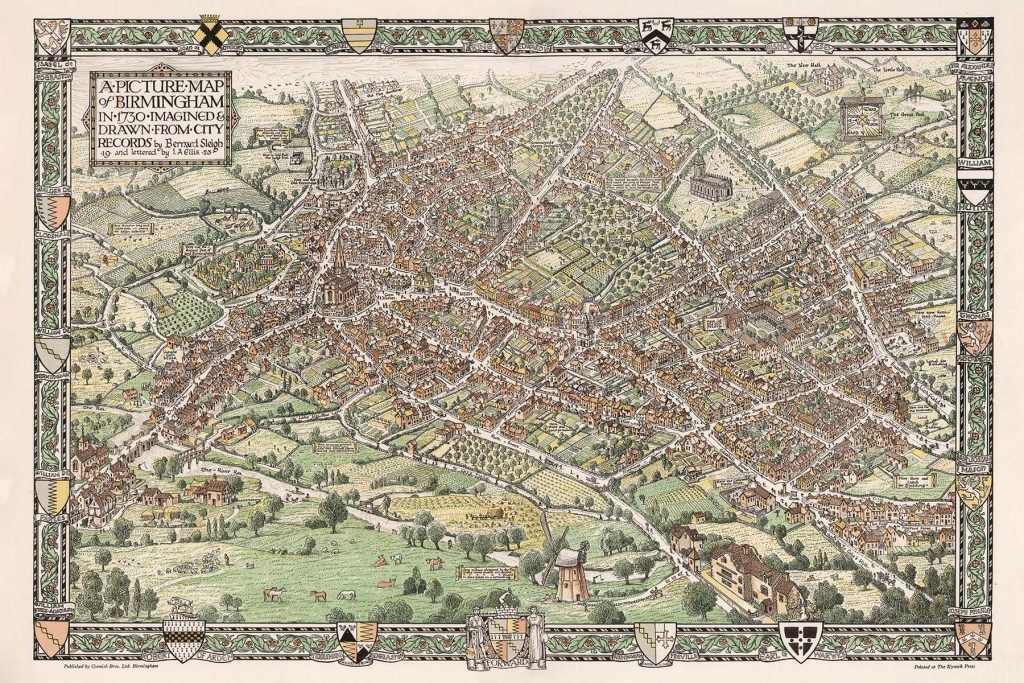
(born in King’s Norton, Birmingham in 1872, d. 1954), a member of the Royal Birmingham
Society of Artists. Lettering by I. A. Ellis. Public Domain.
relevance to one another are examined.
Championed during the past few centuries as a centre of industry, the Atlas celebrates this, yet also a much more substantive, nuanced and fine-grained history of Birmingham. Many aspects of life linked to local, regional, national and international history are examined. A minimalist approach to place and past is rejected in favour of a robust engagement undertaken in a searching and balanced manner. Themes in prehistory, including settlement, beliefs, economy, technology, culture and cultural ecology reference well-established, in addition to the latest archaeology studies and paradigms. Distribution studies in archaeology and cultural and social anthropology evaluate these findings in comparison to relevant material evidence from sites across Western Europe and elsewhere. Exploration is made of the nature, benefits, challenges and tensions of Roman rule. The history, meaning and pronunciation and Celtic and Roman words used then and, subject to translation of culture, today are examined. New opportunities for Saxon (named after those from Saxony in northern Germany, and, arguably, reflective of their seax/sachs or long knives/short swords) and Angle (Latin: Anglii may denote the narrow land of the Angles in northern Germany or hook used in fishing) migrants are examined. The fertile countryside, Celtic people and Roman-era urban sites resulted in culture shock for these new arrivals who had resided outside the Roman Empire. Physical landscape and nature and its symbiotic relationship with people across this and other periods are explored, including the presence of wolves also in the names of some Saxon kings. Place names are examined as are many aspects of cultural, in addition to economic, political, military and social history.
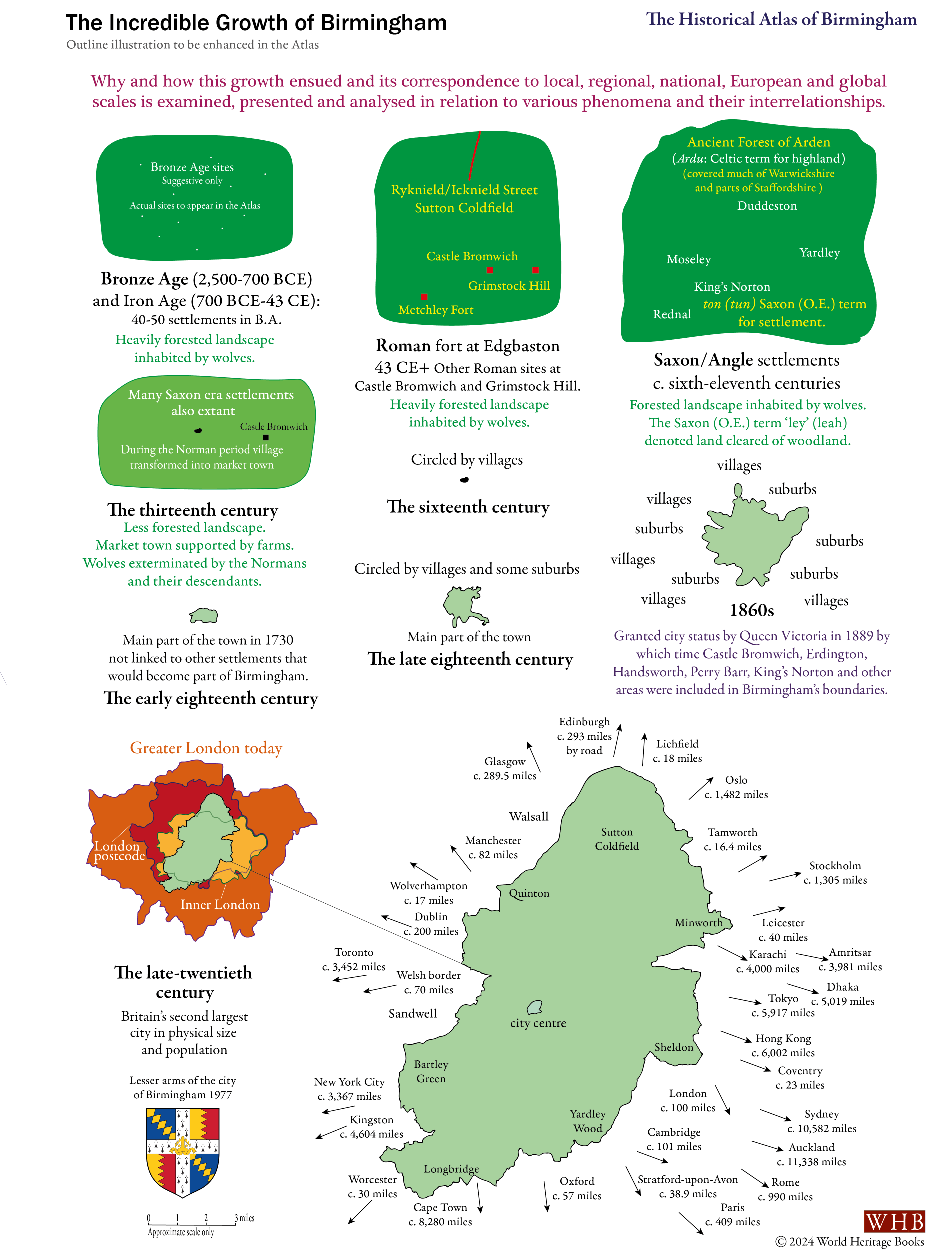
undertaken in a searching and balanced manner.
Acknowledging the challenges of the fifth and sixth centuries, the project refutes the nineteenth and twentieth-century rehash of the ‘Dark Ages’, a term considered to have been coined by Renaissance Italian scholar and poet Petrarch or Arezzo (1304-1374), who frowned on the end of the Roman Empire and much about the subsequent several centuries. The use of this nomenclature and the attitude that underlined it has resulted in a superficial, prejudiced and inaccurate view of the Saxon period. Much insight is provided in the Atlas about this foundational period in the history of Birmingham, including its name (the Saxon leader Birm or Beorma, tribe (ing) and place (ham) in Old German/Old English) and in, and region. Witnessing struggle and determination at all levels and in various spheres of activity by men, women and children, the Saxon and Angle period played a decisive role in the unification of England and gave it Chancery English and England, the name, ideal and kingdom. Linked to this history was the presence of the Danes in land adjacent to the area of Birmingham, a subject also addressed as is the impact of elements of ninth-eleventh century Danish culture, subject to translation of culture, including food, habitation, law, forms of representation, administration, language (berserk, booth, both, cosy, egg, fir, fog, gale, husband, law, ombudsman, window and many other words) and war. Proximity and translation of culture are addressed concerning this and other periods. The rich history of the many parts of Birmingham, whether Acocks Green, Birchfield, Cadbury, the city centre, Digbeth, Edgbaston, Harborne, Kings Norton, Longbridge and West Heath, Moseley, Oscott, Quinton, Sutton Coldfield, Stirchley, Yardley or others wards and areas, roads, streets, and avenues, parks, canals, streams, trees, railway stations, places of worship, learning, culture, industry, finance and other sites are brought out robustly. Reflecting the originality and substantive nature of the project, whilst providing historical depth to many contemporary places, including all sixty-nine wards and various neighbouring locations, and activities, the Atlas also introduces much more distant ages, places, people and phenomena. Much insight into Sutton Park and other sites in the Neolithic Age (over 4,000-c. 2,500 BCE/BC), Bronze Age (c.2,500-c. 700-800 BCE), Iron Age (800 BCE/BC-43 AD/BC) and the Roman, Saxon, Norman, early modern and modern periods is revealed. This multi-layered historical approach contributes to assessing change and continuity and provides much historical depth.
the city over thousands of years are highlighted and celebrated.
In addressing gaps in knowledge and understanding of place, region and periods the project also contributes to ‘mindset levelling-up’ and generates synergies at different scales. Located in the heart of England, Birmingham is neither in the south nor the north and has contributed to both. The area of Birmingham was a strategic location in the pre-Roman and Roman periods. Legio XIV Gemina and Legio XX Valeria Victrix are thought to have been based in Metchley Fort in present-day Edgbaston. These legions may have played a role in the defeat of the rising by the Iceni under Boudica in 61 CE/AD not long after the commencement of Roman rule of Britannia. Sites and settlements across this large area are linked to much regional, national, European and world history. People from the locale and other parts of the region, country, Europe and other parts of the world have influenced this place and its people for thousands of years in many ways. Conversely, Birmingham and its immediate hinterland have impacted England, Britain, Europe and the world. Local, national and global histories of many phenomena, including the history of knowledge: from school to university and substantive links to Oxford and Cambridge, language, medicine, science, technology, textiles, pearl and other buttons, pen production, jewellery, safes, tank and aircraft production, sports, design and motifs, culture, chocolate, food and culture are addressed from a variety of perspectives. During the medieval period, cattle and other economic activity were present and transported to other parts of Britain via this location whose significance is demonstrated on the fourteenth-century Gough Map. New Street was established in the late thirteenth century. The population increased due to the many opportunities offered with many migrating from the Midlands and some from other parts of England and Britain by the late medieval period and thereafter. Plague and famine made its impact here and across the country as did the Reformation. Metalwork and iron merchants proliferated as Birmingham became a much larger urban centre in the seventeenth century. Much activity in science and technology ensued in Birmingham during the eighteenth century as energise and expertise developed over the centuries seemed to burst onto the national and world stage. Industry developed here at a rapid pace. Agriculturalist and agricultural economist Arthur Young described Birmingham as the ‘first manufacturing town in the world.’ Supported by many illustrations, including well-calibrated pioneering maps, timelines, historic scenes, charts, tables and photographs of documents, places, persons and phenomena, the scope and depth of this multifarious story are addressed effectively, in a well-conceptualised, robust and meaningful manner.
other parts of the world are examined.
The aims of the project cannot be achieved by solely focusing on key dates or lengthy studies of a particular period, persons or phenomena. Concerned with micro-historical material and many other scales and types of primary sources and material evidence, the HAB addresses many people, including those whose rule was relevant to the city or was impacted by it. Various historical paradigms are drawn on in addition to those of other disciplines including social theory about cultural capital, power in text, habitus, social hierarchy and Actor Network Theory (ANT). Those who were born and/or resided here and those who visited, including Admiral Horatio Nelson (1758-1805) and Queen Victoria (1837-1901), and contexts across the ages, not solely the most famous are addressed. A framed photograph of Rochdale born Birmingham MP (1858-1889), John Bright who was greatly opposed to slavery, was present in the office of President Abraham Lincoln of the United States (1861-1865). Bright, who defeated a resolution on the House of Commons in 1863 to support the Southern states in the American Civil War may well have been a notable influence on Lincoln’s desire to abolish slavery in the United States. Pens manufactured in Birmingham were used across Britain, Europe, the United States, Africa, India, other parts of Asia, Australia, New Zealand, Canada and elsewhere in that century, exerting technological influence and playing a central role in the cultural, political, economic, education and wider history of many millions of persons across the world. The above and other historical phenomena involved very famous persons and many others from across society. Set against the backdrop of the Civil Wars (1642-1651), located in a parliamentary county, Birmingham witnessed forays by the forces of King Charles I under Prince Rupert of the Rhine in 1643 who was greatly angered by the opposition put up by local militia. The latter impressed Oliver Cromwell and instigated Colonel John Fox to expel royalists from the area.
Key personalities such as Matthew Boulton (1728-1809), a Birmingham-born inventor, engineer and businessman, played a significant role in the changes that ensued here and across Britain and other parts of the world. Several hundred years before the Industrial Revolution, important activities and decisions concerning the unification of England by King Æthelstan (r. 924-939), grandson of King Alfred (r. 871-899), gelled in Mercia at places not far from Birmingham, as the Saxon prince learned much about warfare and politics. Birmingham played a decisive role in supporting the armed forces in the First (1914-1918) and Second World Wars (1939-1945). The city provided huge amounts of manpower, tanks [most Mark IV tanks built in Britain during the First World War were manufactured at the Metropolitan factory in Birmingham] and other vehicles, and aircraft, including over 10,000 Spitfires [more than half the total number built], ordnance and much else, and throughout the Cold War. The Town-class light cruiser, HMS Birmingham (1913) participated in the Battle of Heligoland (the first British-German naval battle of the First World War, fought on 28 August 1914 and fought in the North Sea, the Battle of Dogger Bank (24 January 1915) and the famous Battle of Jutland (31 May-1 June 1916). The impact of the city of Birmingham has resonated in other ways too. Reflective of its aims and scope, historical links with other places named Birmingham in North America and elsewhere are also examined and renewed. Nuance, symbiotic relationships and connectivity rather than simplicity are demonstrated and analysed.
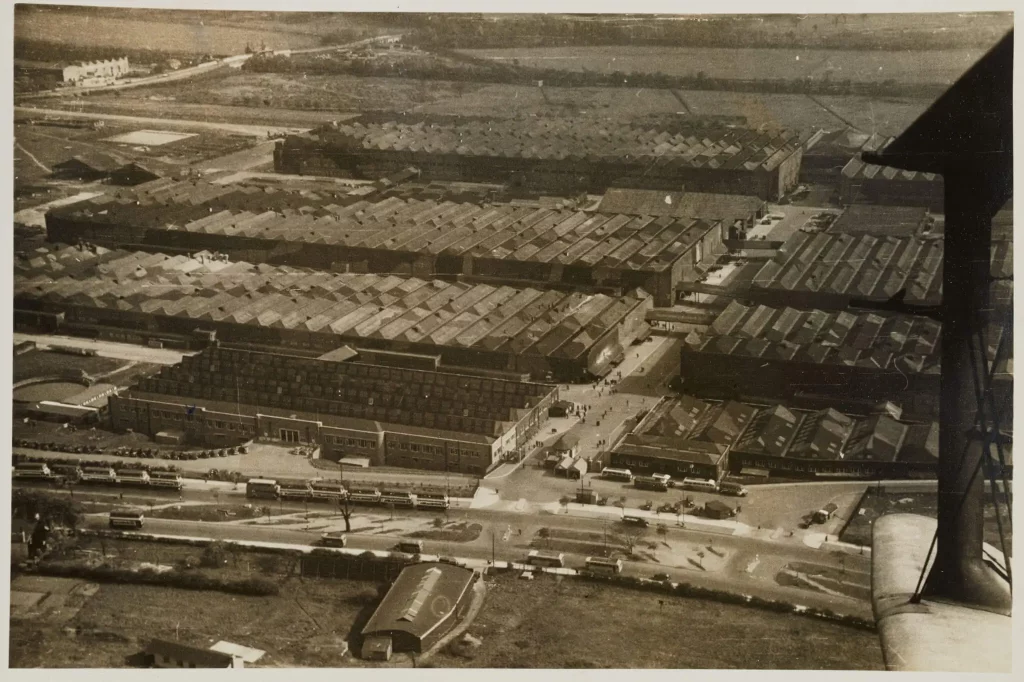
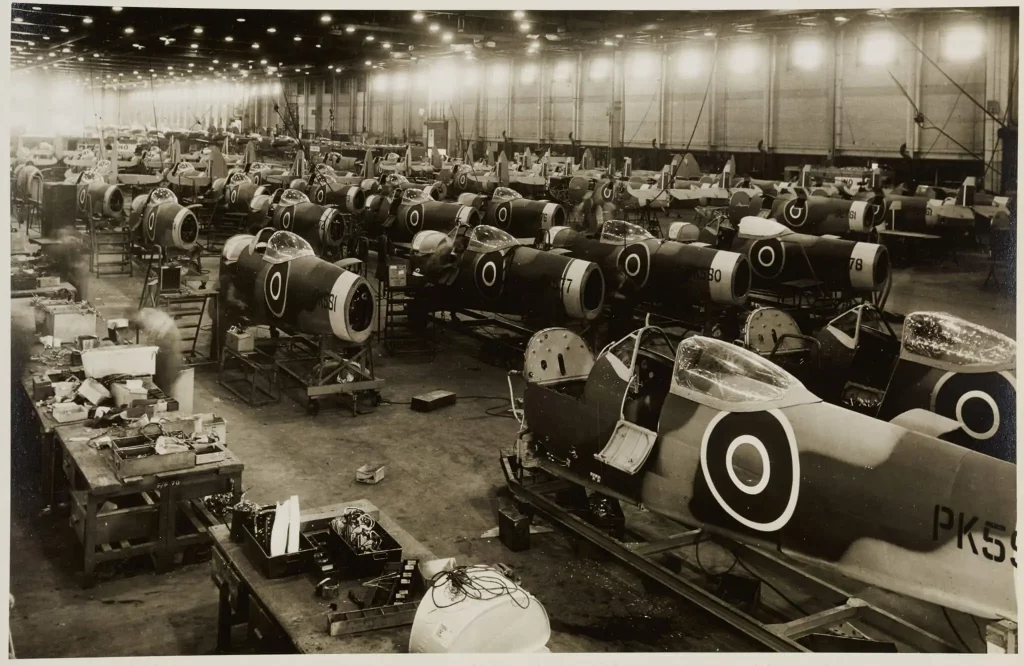
depicted and explained authoritatively.
The many sub-projects that the HAB comprises are carefully addressed and brought together in a manner that contributes to knowledge and understanding, engages the reader and reflects the history and archaeology of this city. Due to the overlapping nature of themes, phenomena and issues addressed, many aspects of the Atlas are interlinked. Therefore, the project provides a multifaceted and multi-perspective insight into the city’s history and its dynamism. In addressing this scope and scale of the past, an unprecedented body of expertise from various disciplines and specialisms shall contribute to the many different elements of this project. Contributors are based in Birmingham, other parts of the Midlands, Britain, Europe and the world. Commissioning, conceptualising, integrating and presenting this multi-disciplinary project is undertaken carefully. Reflective of the nature of the investigation and presentation of archaeology, history and knowledge various research processes are adopted. This issue is outlined during the research process and in the Atlas, reflective of our commitment to transparency of aims, methods and information. Research ethics are adhered to from the outset and post-publication engagement. Subject matter and persons are addressed respectfully and sensitively. Although different points of view are presented, evidence and interpretation are presented effectively. Readership is engaged in a thoughtful manner rather than imposed on. Vast information and its analysis are presented, new avenues of inquiry are addressed, and additional questions are generated. Limitations of knowledge, including sources and material drawn on, are made known. A substantive set of glossaries of places, people, phenomena and terms is generated and presented at the end of the Atlas followed by an extensive bibliography and index. Printed on acid-free art paper of high quality, the HAB will be illustrated and designed to high standards. Facilitating civic education, synergies are established via this substantive educational project that contributes to cohesion at local, regional, national and global scales. Generating interest across the city and the world, this project establishes new benchmarks in urban history and other fields and will contribute to global insight into this city amidst continued expansion and innovation in the twenty-first century.
Further details of this and other special projects to be announced later in 2024 and 2025.

